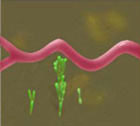Microscopic Interaction of Cancer Cells and Blood Vessels Captured In Photos Through 'Window' Into Body
Close-ups support use of angiogenesis inhibitor drugs.
View photos
 |
| Implanted cancer cells, glowing with green fluorescence
protein, grow toward blood vessel. |
January 18, 2000. Researchers from Duke University Medical Center and Duke Comprehensive Cancer Center have documented for the first time the earliest steps of the organization of cancer cells into tumors in mice and rats. The findings, they say, reinforce current approaches to curb the spread of cancer.
The study, which mimics the formation of tumors distant from the initial disease site, shows that the growing tumor forms new blood vessels when just hundreds -- not millions as previously believed -- of cancer cells are present. By including a specific blocker of new blood vessel formation, a so-called angiogenesis inhibitor, the scientists also showed that cancer cells' communication with the nearby blood vessels and the migration toward them are necessary for the cancer cells' initial survival, even before they actively create new vessels.
The scientists' observations imply that angiogenesis inhibitors might be useful at the earliest stages of tumor development, supporting their use to prevent recurrence and spread of cancer, said lead author Chuan-Yuan Li, assistant professor of radiation oncology. In addition, chemotherapeutic agents used following surgery for some cancer might be able to reach metastatic tumors only a fraction of the size previously thought accessible.
The results are published in the January issue of the Journal of the National Cancer Institute. The study was funded in part by the National Cancer Institute, the department of radiation oncology at Duke University Medical Center, and the Duke University Medical Center Specialized Program of Research Excellence (SPORE) in Breast Cancer.
Scientists generally believe that primary tumors, which sprout following certain changes within a cell, first form a lump about the size of a pin-head that stops growing when oxygen levels become too low. This situation, called hypoxia, then stimulates new blood vessel formation, allowing the initial lump of one million to 10 million cells to keep growing.
While many researchers assumed the same angiogenesis process would occur in metastatic tumors, which form when a primary cancer cell escapes and takes up residence elsewhere, Li and his coworkers wanted to see for themselves. Their animal model mimics metastases because the cancer cells are implanted into an area where they would not form initially.
"When you have cancer cells distant from the primary site, the mechanisms of angiogenesis could be the same, or they could be different," Li said. As a result, the scientists watched closely as implanted cancer cells organized themselves into the beginnings of a tumor.
To visualize the tumors' origin from the earliest stage, the researchers made the cancer cells glow by modifying them to express a molecule known as green fluorescence protein. The glowing cells were then injected into a special window chamber on each rodent's skin that allows the tumor cells to receive needed nutrients and the researchers to monitor tumor growth without sacrificing the animal.
The scientists saw that the three or four implanted cancer cells that survived the first few days actually aligned and, as they multiplied, reached toward nearby existing blood vessels. By the eighth day, the cancer cells, now numbering 100 to 300, had created visible, fully-functioning new blood vessels, said principal investigator Mark Dewhirst, professor of radiation oncology.
Even though up to eight days were needed for the growing tumor to form new blood vessels, a second experiment showed that existing blood vessels and cancer cells must be able to communicate somehow for the implanted cancer cells to survive. When an inhibitor of a specific angiogenesis pathway was injected along with the cancer cells, all of the cells died without reaching out toward existing vessels. Without the inhibitor, at least a few cells always survived to begin forming a tumor.
The inhibitor was a shortened, inactivated version of the protein receptor for vascular endothelial growth factor, or VEGF, a molecule involved in vessel dilation and other processes. The inactive receptor basically tied up the VEGF, preventing it from binding to active cellular receptors. While the essential step of the VEGF pathway necessary for tumor survival isn't known, the effect of blocking the whole pathway was striking, the scientists said.
"What we saw in our study was a mutual attraction between the growing tumor and the nearby blood vessels," Dewhirst said. "Now we need to identify what the attractants are, and that might give us new targets for therapies."
While the cancer cell line used for their experiment is known to express VEGF to a high degree, the study demonstrates that using an angiogenesis inhibitor can prevent cancerous cells from taking root. While various angiogenesis inhibitors are currently in clinical trials to evaluate their ability to prevent cancer recurrence, this study is the first to show that they might work by preventing initial cell survival, as well as by preventing blood vessel formation needed for an established tumor to keep growing.
Dewhirst and his colleagues, including research associate and study co-author Siqing Shan, have long used the window chamber model. The green fluorescence protein was recently added in order to study various aspects of early tumor development. It is impossible to detect a tumor when it consists of just a few cells in any other animal model, the scientists said.
Other co-authors on the study were Qian Huang, Rod Braun, Jennifer Lanzen, Kang Hu and Pengnian Lin, all of Duke University Medical Center.



